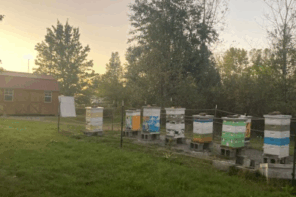Our Medina County Beekeepers Association runs a booth at the Medina County fair every summer. We’re pretty typical of most beekeeping groups when it comes to our fair behavior. We have a booth in one of the buildings…we share space with the vegetable show people, the soil and water conservation folks, the local Farm Bureau, and the hay competition.
We have a sales booth where we display all the honey our members sell, candles, honey sticks and other trinkets and items. There’s a space where the observations hive sits, and next to that is the small table where kids can roll candles made from colored beeswax foundation.
The building is much longer than wide, and has all these booths running down each long side with a wide isle in the middle of the building where there’s a few benches for a comfortable place to avoid the sun, or sometimes the rain.
We have a large area on one side of the isle that’s divided into two sections, and across the isle and down a little we have another space where we have the back-lit cabinet that shows our honey contest display, and a space for the hands-on beekeeping equipment table with frames, supers, beesuits, covers and the like. In the middle of this area is a table with a TV hooked up to a DVD player that runs a beekeeping video on a loop, all day, every day, all week long.
In the sales booth, which is by far the largest area we have, we keep the cases of honey that members brought in, the cash register, the schedule book, and on the wall behind the counter shelves with extra bottles of honey, candles and the ‘stuff’ that makes the booth run each year.
The photo shows the sales area with the counter on the left and shelves along the wall on the right. Fans make the hot weather bearable, and enough chairs help us old folks when the traffic is slow.
This design has evolved over the years, each time becoming a bit more efficient, focused and changing with the times. We used to have an extraction demonstration every evening, but that paled after several years and attendance waned. But it’s been awhile and we may bring it back again soon. We’ve had displays of antique extractors, a variety of bee suits, various beehive styles and other gear, and there are posters from ceiling to floor on every blank space on every wall.
In front of the sales counter we have step shelves with lots of honey displayed on the steps. Customers can look at the bottles and labels and ask to taste one or more. Everybody who sells has a unique ‘mark’ on every bottle they sell…a gold star, green star, red dot, yellow dot…or two or more of these or other sticker markers. On the counter we have taster bottles supplied by each seller…usually a 12 ounce squeeze…with an identical mark on it, so someone behind the counter can identify the taster by looking at the bottle the customer wants. And that’s what you spend most of your time doing…asking if a curious walk-by would like to taste some wonderful local honey…then getting them involved in the differences of all the honeys we have, the value of bees, how to use honey, and which one do you want. It’s not high pressure, but it’s a little pressure. And it’s how we make our spending money every year.
The club buys the honey from each member at a price club members agree on, then mark it up for sales at the fair. For some members this is the way they sell most of their honey every year. If you want to sell at the fair you have to work a set number of shifts during the week, and, it used to be, have an entry in the honey show. They changed that recently though. The difference between what the club buys honey for and what we sell it for is money the club keeps to run the organization every year…it pays for the attendance fee for the workers at the fair for beginners, but it helps with speakers, fair booth improvements, our Christmas dinner, meeting goodies and other things we couldn’t afford otherwise. It’s the primary fund raiser we have every year, so there is seriousness at every level.
Honey flows in northeast Ohio seldom yield a significant varietal honey flow…sometimes we’ll get a locust crop, and once in awhile some basswood, but mostly it’s a blend of everything out there. Later in the summer we’ll have a good goldenrod flow, and some years we’ll have a lot of golden honey plant honey…and of course clover is pervasive in every blend. So smart sellers here make their distinctions by season…early season honey is usually lighter and milder than mid-summers flows that are a bit darker and stronger, and fall flow honey is usually darker yet, and a bit stronger…but not always.
Sometimes a member who does a bit of pollination will come up with apple honey or maybe pumpkin honey…but mostly, and without fanfare, we sell Ohio wildflower. Oh well….
But last year creativity and inspiration visited our booth, and one of our members started selling infused honey. He had, I believe, only Jalapeno pepper infused honey…but it sold like nothing else on the shelf. Our members noticed.
Now infused honey is nothing new. I had recipes in my first book seven years ago, The Backyard Beekeeper, and beekeepers have been doing this longer than anyone I know can remember. It isn’t new. But it was new to us last year.
So this year…we had almost as much infused honey on sale as we did Real Raw honey, Spring Harvest, Summer Blossom or Autumn Gold honey. There were infusions of pepper, citrus rind, cinnamon, anise, spice, and others I neglected to write down. And they all sold well…especially the pepper and cinnamon.
I worked two shifts this year…usually the fair and EAS are the same week, and I miss a lot of our fairs, but this year they were different so I got to be a part of it…and can vouch for the popularity of infused honey…it’s the “NEW” thing in Medina, and we sold a lot of it.
You can google infused honey and come up with recipes and techniques…we’ve make lavender, rosemary, lemon balm, and pineapple sage infused honey over the years…all are popular with our friends, and all are easy to make.
So. Infused honey. Make some this year. Put a special label on it. Maybe a special container and sell it for twice what you normally get for honey. Once your customers taste your special honey with that hint of….whatever…they won’t mind at all. Get your honey outside that box…









